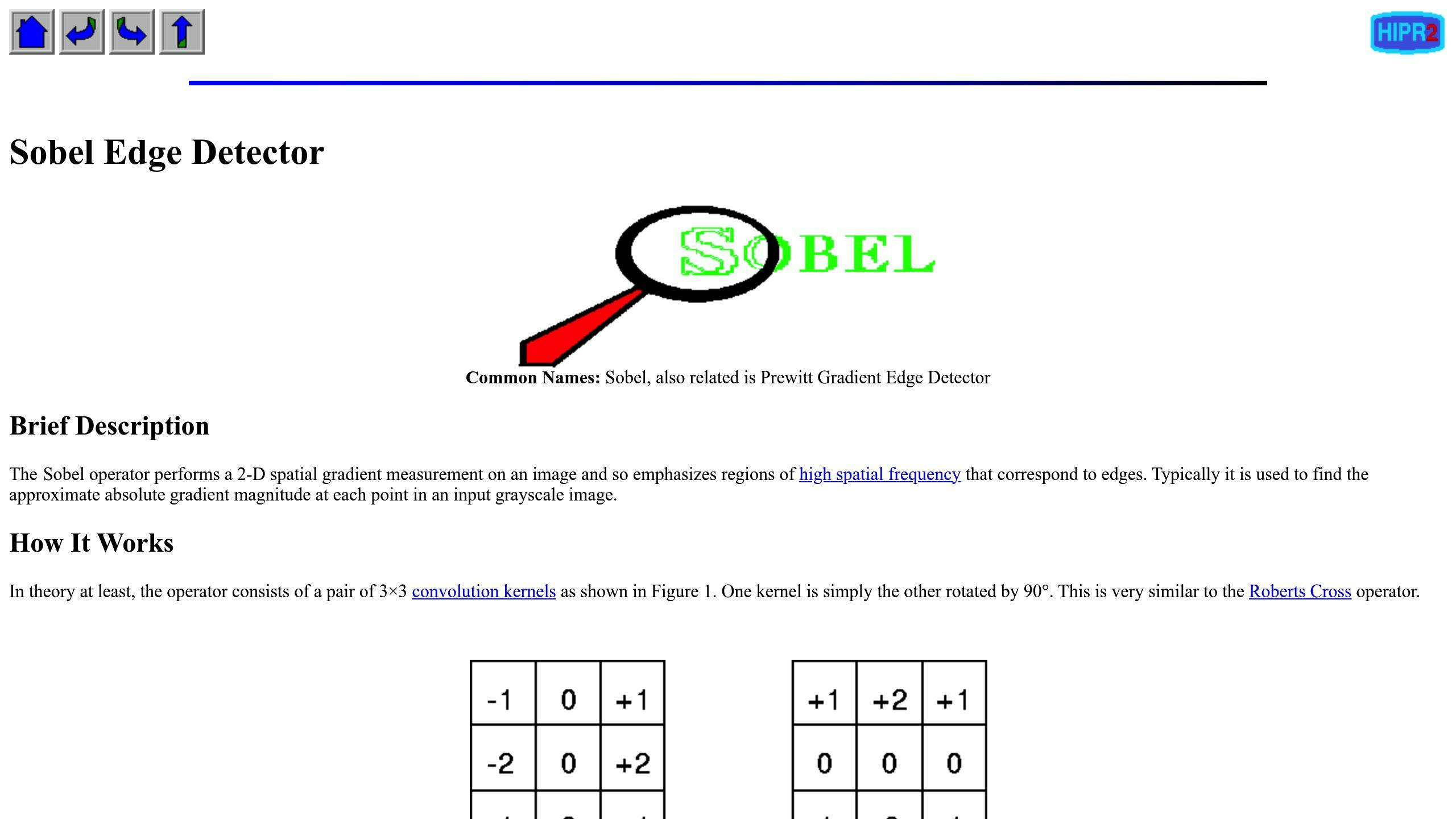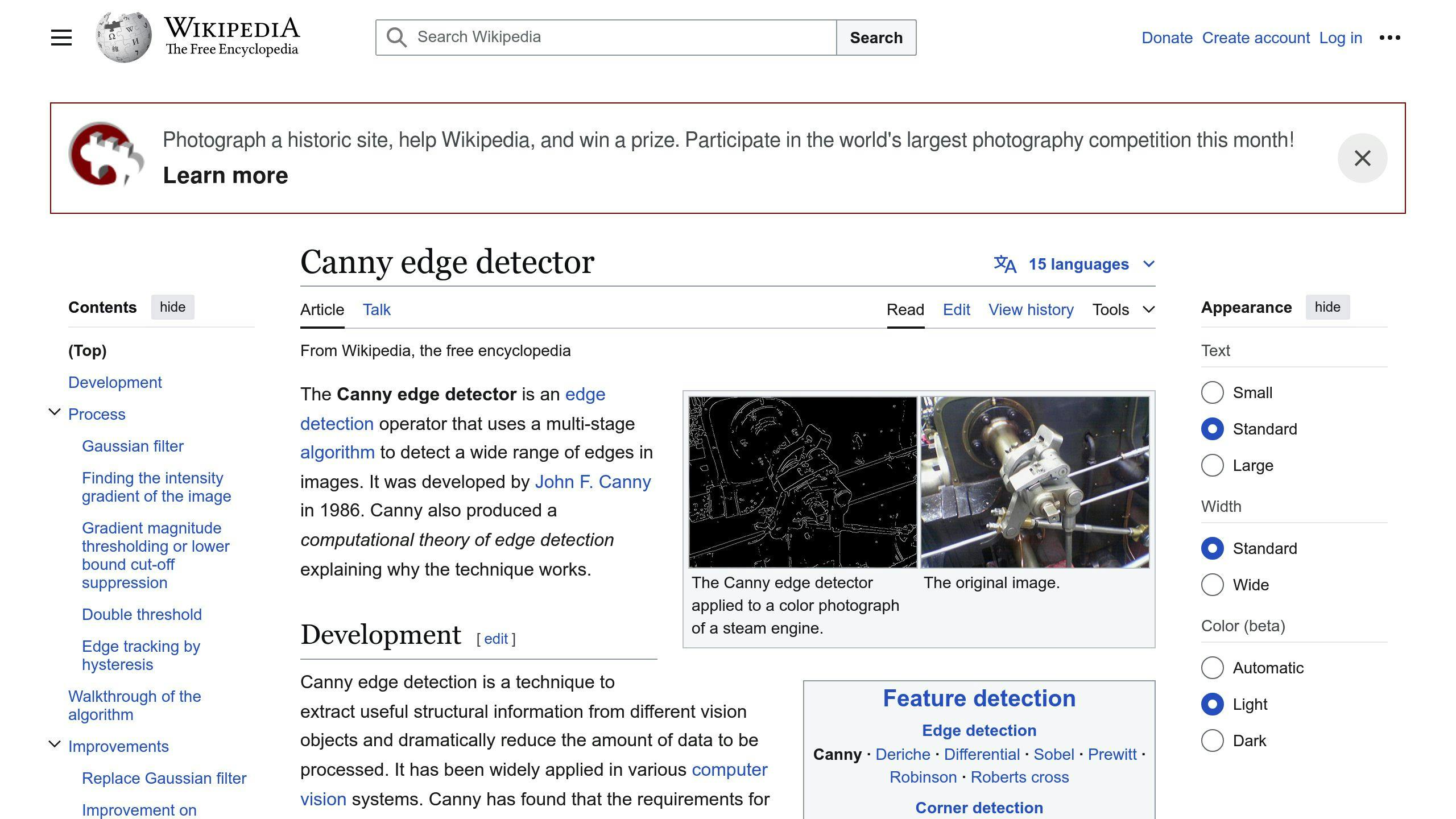
Comparing Edge Detectors in Noisy Images: Performance Metrics
Edge detection is crucial in image processing, but noise can make it tricky. Here's how three popular edge detectors stack up:
Quick comparison:
| Feature | Sobel | Canny | LoG |
|---|---|---|---|
| Speed | Fast | Slow | Medium |
| Noise handling | OK | Excellent | Good |
| Edge accuracy | Medium | High | High |
| Complexity | Simple | Complex | Medium |
Key findings:
- Canny performs best in noisy images
- Sobel is fastest but struggles with noise
- LoG is good for blob-like shapes but sensitive to noise
Performance metrics used:
- Mean Squared Error (MSE)
- Peak Signal-to-Noise Ratio (PSNR)
- Figure of Merit (FoM)
Bottom line: Choose your edge detector based on your image type and noise level. There's no one-size-fits-all solution.
Related video from YouTube
Sobel Operator

The Sobel operator is a big deal in edge detection. It finds where image brightness changes fast, helping spot edges.
Here's what it does with noisy images:
- Uses two 3x3 masks to check horizontal and vertical changes
- Smooths things out a bit, helping with noise
- Tells you which way edges point
Let's see how Sobel stacks up against the Canny edge detector:
| Feature | Sobel | Canny |
|---|---|---|
| Complexity | Simple | More complex |
| Noise Handling | OK | Better |
| Edge Accuracy | So-so | High |
| Speed | Faster | Slower |
| Edge Look | Thicker | Thinner, precise |
Without noise, Sobel hit 86.5% accuracy on 11,355 images. Not bad, but Canny nailed 97.6%.
Sobel shines with noisy images because it's:
- Fast (great for real-time stuff)
- Built to handle some noise
- Easy to set up in hardware and software
Want Sobel to work better with noise? Try these:
- Use Gaussian blur first
- Try median filtering before edge detection
2. Canny Edge Detector

The Canny Edge Detector is the Swiss Army knife of edge detection algorithms. It's especially good at handling noisy images.
Here's how Canny works its magic:
1. Noise reduction
Canny starts by smoothing the image with a Gaussian filter. This knocks out some noise right off the bat.
2. Gradient calculation
It then finds areas where image brightness changes quickly, using tools like the Sobel operator.
3. Edge thinning
Canny uses non-maximum suppression to thin out edges, creating crisp, well-defined lines.
4. Double thresholding
This is where Canny shines. It uses two thresholds to classify edges:
| Edge Type | Description |
|---|---|
| Strong | Definitely edges |
| Weak | Maybe edges, maybe noise |
| Non-edges | Ignored |
5. Edge tracking
Canny connects the dots, deciding if weak edges are real based on their connection to strong edges.
Compared to other edge detectors:
| Feature | Canny | Sobel | Prewitt |
|---|---|---|---|
| Edge Quality | High | Medium | Medium |
| Noise Handling | Excellent | Good | Good |
| Speed | Slower | Fast | Fast |
| CPU Usage | Higher | Lower | Lower |
Canny's multi-step approach makes it more complex, but it pays off. It finds more edges and handles noise better than simpler methods.
"The Canny edge detection algorithm is widely regarded as one of the most effective and accurate edge detection techniques."
This reputation is well-earned. Canny consistently outperforms other edge detectors, especially in noisy images.
But it's not perfect. It's slower and needs more computing power. Setting those thresholds can be tricky, too.
To get the most out of Canny:
- Start with default thresholds, then adjust.
- For very noisy images, increase the Gaussian filter size.
- Consider adaptive thresholding for different image types.
sbb-itb-cdfec70
3. Laplacian of Gaussian (LoG)

LoG is a smart edge detection method. It does two jobs at once: cuts down noise and finds edges. Here's the gist:
1. Smooth it out
First, LoG uses a Gaussian filter to reduce noise. This step helps avoid detecting fake edges.
2. Find the changes
Next, it calculates the second derivative of image intensity. This highlights where intensity changes quickly.
3. Spot the crossings
Edges are where the second derivative hits zero.
LoG uses a single 5x5 kernel, so it's pretty quick. But it's touchy about noise, which is why that first smoothing step matters.
| Feature | LoG | Canny | Sobel |
|---|---|---|---|
| Noise Handling | Good | Excellent | Good |
| Computational Speed | Fast | Slower | Fast |
| Edge Quality | High | High | Medium |
| Sensitivity to Noise | High | Low | Medium |
To get LoG working well:
- Tweak the Gaussian filter size based on how noisy your image is
- Set a good threshold to tell edges from noise
- Use LoG when you need speed and noise isn't too bad
LoG is great for finding blob-like shapes. It's often used in medical and satellite images.
One last thing: LoG works best when you pick the right scale for the Gaussian filter. Too small? You'll get noise. Too big? You'll miss important edges.
Strengths and Weaknesses
Let's compare Sobel, Canny, and Laplacian of Gaussian (LoG) edge detection algorithms:
| Algorithm | Strengths | Weaknesses |
|---|---|---|
| Sobel | - Fast - Good for simple images - Smoothing effect |
- Noise-sensitive - Struggles with complex images |
| Canny | - Good localization - Noise-resistant - Handles complex images |
- More complex - Time-consuming - Resource-heavy |
| LoG | - Detects edges and corners - Thin, accurate edges |
- Very noise-sensitive - Needs large kernel for smoothing |
Sobel is your speed demon. It's quick and works well on simple images. But throw in some noise or complexity, and it might miss the mark.
Canny? It's the heavyweight champ of edge detection. It laughs in the face of noise and tackles complex images like a pro. A study on ultrasound images proved Canny's superiority:
"For the left common carotid artery, the MSE values for Canny edge detection were significantly lower than those for Sobel, Prewitt, Roberts, and LOG edge detections (P-Value < 0.05)."
But all that power comes at a price - it's slower and needs more computing muscle.
LoG sits in the middle. It's great at finding edges in images with varying intensity and spotting blob-like shapes. But it's a bit of a drama queen when it comes to noise.
So, which one should you pick? It depends on what you're dealing with. Got clean, simple images and need speed? Sobel's your guy. Complex or noisy images where accuracy is key? Go for Canny. Images with varying intensity or blob-like features? LoG might be just what you need.
Wrap-up
After comparing Sobel, Canny, and Laplacian of Gaussian (LoG) edge detectors in noisy images, here's what we found:
Canny comes out on top. It's the best, especially when there's noise. A study on ultrasound images proves it:
| Metric | Canny (CCA) | Sobel (CCA) | Canny (BA) | Sobel (BA) |
|---|---|---|---|---|
| MSE | 0.0003 | 0.0004 | 0.0005 | 0.0009 |
| PSNR | 85.6530 | 84.2164 | 82.4307 | 79.1419 |
Canny's lower MSE and higher PSNR show it handles noise better.
Sobel? It's quick but doesn't like noise. It's fine for simple, clean images. But throw in some noise, and it struggles.
LoG is good at finding edges when intensity changes. But noise? It's not a fan. In fact, it had the worst MSE and PSNR in the study.
So, what should you use?
- Need accuracy in noisy situations (like medical imaging)? Go for Canny.
- Working with simple, clean images and need speed? Sobel's your guy.
- Dealing with varying intensity and blob-like features? LoG might work, but watch out for noise.
Bottom line: Pick your edge detector based on what you need and what your images look like. There's no one-size-fits-all solution here.
FAQs
What are the performance metrics for edge detection?
Edge detection quality in image processing is measured using these key metrics:
1. Mean Squared Error (MSE)
This measures how different the processed image is from the original. Lower MSE? Better edge detection.
2. Peak Signal-to-Noise Ratio (PSNR)
PSNR compares the max signal power to noise power. Higher PSNR means better edge detection.
3. Structural Similarity (SSIM)
SSIM looks at how similar the processed image's structure is to the original. Closer to 1? Higher quality edge detection.
These metrics help compare edge detection algorithms. Check out this example from a study:
| Metric | Canny (CCA) | Sobel (CCA) | Canny (BA) | Sobel (BA) |
|---|---|---|---|---|
| MSE | 0.0003 | 0.0004 | 0.0005 | 0.0009 |
| PSNR | 85.6530 | 84.2164 | 82.4307 | 79.1419 |
The Canny edge detector beat Sobel in both MSE and PSNR. This shows it's better at handling image noise.